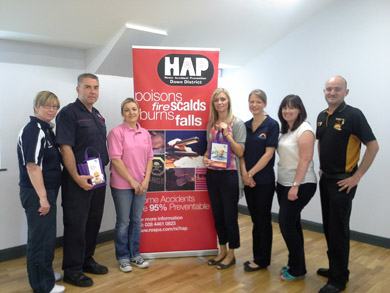Down Home Accident Prevention (HAP) have held a Safe Families Event in the Ballymote Centre to inform families from across the district of everyday hazards that may affect them and their children.
Demonstrations on home safety, car seat safety, first aid and fire safety in the home were given to the families in attendance. The Key messages that the demonstrations highlighted were:
On Blind Cords
[caption id="attachment_50817" align="alignleft" width="390"] Supporting the event and pictured above are Jenny Laverty (County Down Rural Development Network); Gerry McGrady (NIFRS), Sharon Robson (HomeStart); Charlene Magill (HAP); Niamh Wallace (SureStart); Heather Holland (County Down Rural Development Network); and John Reville (Halfords, Downpatrick).[/caption]
Supporting the event and pictured above are Jenny Laverty (County Down Rural Development Network); Gerry McGrady (NIFRS), Sharon Robson (HomeStart); Charlene Magill (HAP); Niamh Wallace (SureStart); Heather Holland (County Down Rural Development Network); and John Reville (Halfords, Downpatrick).[/caption]
The majority of homes now have blinds fitted in their homes, with an estimated 200 million currently fitted in homes and offices across the country, which may account for this large number of deaths.
The Down Home Accident prevention Group would like to offer the following advice to all parents, relatives and carers of young children on how to make their blinds safe.
To reduce the risk posed by looped cords, including blind cords, cords should be kept out of the reach of children. Tie up the cords or use one of the many cleats, cord tidies, clips or ties that are available
Cutting cords is not recommended, even as a short-term solution
Pull cords on curtains and blinds should be kept short and kept out of reach
All parents, relatives and carers of young children are advised to do a quick audit of their home and make sure any window blinds cords are made safe.
Burns and Scalds
Every year many children in Northern Ireland attend the Accident & Emergency as a result of Burns & Scalds in the Home and some children are admitted to Hospital and may even require plastic surgery leading to permanent scarring to their body. Horrific injuries can occur very quickly as children’s skin can be 15 times thinner than adults.
Hair straighteners have become one of the leading causes of burns to children.
To prevent burns to children always ensure the straighteners are switched off after use and un-plugged and put out of reach from children. They should be stored in a safe place on a heat proof mat or in the heat pockets supplied. Never leave them unattended when in use.
Falls
Falling is the most common type of accident in the home AND can cause serious injury at any time of life. Fifty-five per cent of accidental injuries in the home involve falls. Families with young children are given the following advice: –
* Baby bouncers – keep them on the floor. Never to be set on tables and worktops. * High chairs – use a five point safety harness. This is a strap between the baby’s legs, straps that go over the baby’s shoulders and straps that go under the baby’s arms. * Parents should always change a baby on the floor to prevent any falls. * Bunk beds – Anyone under 6 years old should sleep on bottom bunk only. * Stairs – securely fix stair gates, preferably at the top and the bottom of the stairs and always use them safely. * Windows – fit window restrictor bars to stop children from falling out. * Move furniture such as beds and chairs away from windows to prevent children from climbing
Fire Safety
The Northern Ireland Fire and Rescue Service would gave families the following advice: –
* Don’t forget to carry out your night-time fire safety check * Never leave candles unattended
* Don’t overload electrical sockets
* planned your escape route and know where to go
* Never let children play with matches or cigarette lighters
* Never leave candles unattended
* Don’t overload electrical sockets
* planned your escape route and know where to go
* Never let children play with matches or cigarette lighters
Car Seat Law
Children under three years of age must always be carried in a baby or child seat appropriate to their weight. Children aged three to 12 and under 135 cm (whichever occurs first) must use a booster seat or cushion and children over 135 cm must use a booster cushion or adult seat belt.
]]>

























